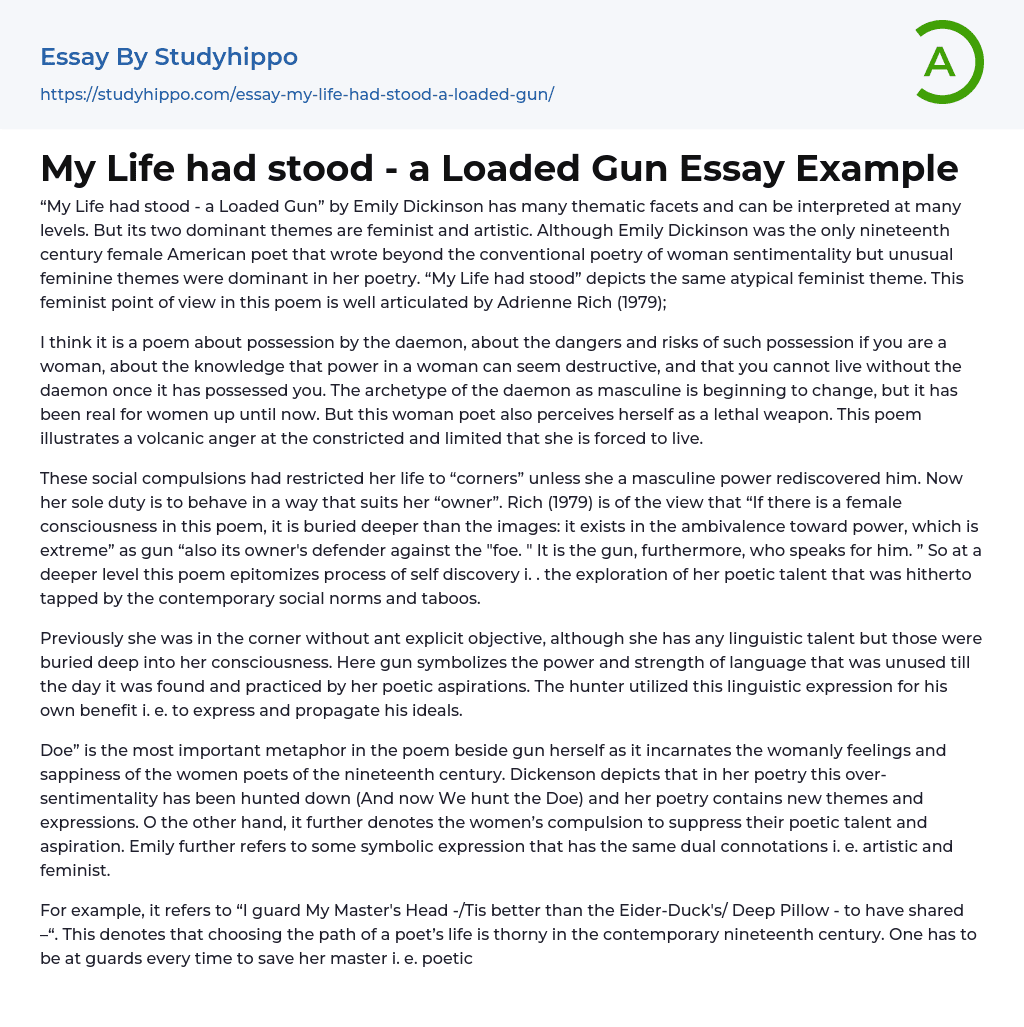Emily Dickinson's "My Life had stood - a Loaded Gun" is a multi-faceted poem with distinct feminist and artistic themes. Despite Dickensons's unique position as the only nineteenth-century American female poet to transcend typical sentimental poetry, her work indicates a strong feminine theme. This atypical perspective of feminism is also apparent in the aforementioned poem. Adrienne Rich accurately communicates the feminist undercurrent in this poem in 1979, stating:
This poem can be interpreted as representing the struggle of possession by an inner force, highlighting the hazards and pitfalls this can present for a woman. It acknowledges how power can appear destructive when embodied by a woman and emphasizes the dependence on this power once it encapsulates her. Although traditionally, this internal force is portrayed as masculine, this perception is gradually changing. H
...owever, it has been a palpable reality for women until now. The presiding sentiment in this poem, however, is that the female poet sees herself as a deadly force. It abundantly highlights an eruptive resentment towards the confined and restricted life she is compelled to endure.
Her life had been limited by societal expectations, trapped in metaphorical "corners" until a masculine entity gave her recognition. Now, she must conform to the pleasing ways of her "master". According to Rich (1979), there might be a feminine consciousness present in this poem, though deeply buried beneath the imagery: it is seen in the ambivalence towards power which is extreme. The gun is also seen as the defender of its owner against enemies and it is the gun that speaks on behalf of him. Hence, below its surface, this poem symbolizes a journey of self-exploration, particularly referring to he
poetic potential that had been suppressed by prevailing societal norms and restrictions.
Formerly, she resided in the corner without a clear purpose, despite possessing latent linguistic abilities. These talents were deeply hidden in her consciousness. The gun here signifies the unused power and strength of language, which lay dormant until discovered and honed through her poetic ambitions. This linguistic prowess was exploited by the hunter for his own advantage, namely to articulate and spread his ideologies.
"Doe" stands as a significant metaphor in the poem next to the gun itself, symbolizing the feminine emotions and excessive sentimentality found in the works of female wordsmiths of the 1800s. Dickinson portrays that such pronounced sentimentality has been pursued and negated in her poetry (And now We hunt the Doe) and incorporated fresh themes and expressions. Moreover, it connotes the societal pressure female poets often faced to curb their artistic ambition and potential. Furthermore, Emily employs several symbolic phrases that carry a similar duality in meaning; embodying both an artistic and feministperspective.
An illustration is made to the reference "I guard My Master's Head -/Tis better than the Eider-Duck's/ Deep Pillow - to have shared –". This symbolizes the struggles an individual faces in choosing a path as a poet during the challenging nineteenth century. A person must remain vigilant to safeguard her master: that is, her poetic life or journey. From a feminist perspective, "the speaker seems to prioritize guarding the master over sharing his pillow, suggesting she favours her role as guardian over seeking close personal relationships with him-- perhaps of a romantic or sexual nature as inferred by the general poem's context." (Miller, 1987).
The final verse demonstrates
Dickenson's exceptional skill in merging her personal experiences with deep philosophical thoughts and rich poetic diction. This verse, however, also reveals some complex and perplexing aspects of her psyche. "He longer must—than I— For I have but the power to kill, without--the power to die," she contemplates. Regardless of the vast energy she perceives herself to possess, sufficient to illuminate an entire valley, she asserts that she remains deadly without the presence of an owner or controller.
In the event that she loses possession, this idea is deemed unfathomable: "He must outlast me." (Rich, 1979) However, Albert Gelpi (1979), a modern critic of Rich's work, introduced a different perspective. He believed this verse revealed Dickinson's philosophical musings on the subject of “mortality and survival." He suggests that reading the line "Without--the power to die" as "except for the power to die," or "unless I possessed the power to die," allows the verse to take on a new meaning. It would then imply: unless she was mortal or didn't possess the ability to die, her only alternative would be the power to kill.
Alongside its thematic expressions, Dickinson uses the structure of her poem to effectively communicate her message. Every noun in the poem is capitalized to signify their importance and relevance. The poem is a stunning combination of Dickinson’s artistic brilliance and her commentary on women's condition, particularly female poets of her time. Rich (1979) sums it up perfectly: “this is a pivotal poem in understanding both Emily Dickinson and ourselves, as well as describing the state of female artists, especially in the nineteenth century."
- Family essays
- Wealth essays
- Punctuality essays
- Carpe diem essays
- Persistence essays
- Chicken essays
- Crops essays
- Object essays
- Adaptation essays
- Love Story essays
- Mystery essays
- Thank You essays
- Hero essays
- Farm essays
- Focus essays
- Development essays
- Welding essays
- Nursing essays
- Integrity essays
- Hypocrisy essays
- Mother Tongue essays
- Contrast essays
- Secret essays
- First Love essays
- Motherhood essays
- Beauty essays
- Alcohol essays
- Aging essays
- Narcissism essays
- Myself essays
- Greed essays
- Limitations essays
- Fire essays
- House essays
- Peel essays
- Evil essays
- Humility essays
- Perspective essays
- Dream essays
- Change essays
- Choices essays
- Toys essays
- Experience essays
- Wisdom essays
- Transport essays
- Barbie Doll essays
- Adversity essays
- Lifestyle essays
- Housing essays
- Holiday essays




